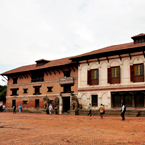Kathmandu,
Nepal
Kathmandu is the capital and, with
close to one million inhabitants, the largest metropolitan
city of Nepal. The city is the urban core of the
Kathmandu Valley in the Himalayas, which contains
two sister cities: Lalitpur (Patan), 5 kilometres
(3.1 mi) to its south and Bhaktapur or Bhadgaon,
12 kilometres (7.5 mi) to its east, and a number
of smaller towns. It is also acronymed as 'KTM'
and named 'tri-city'. In the last census (2001),
the city of Kathmandu had 671,846 inhabitants. Population
estimates for 2005 were 790,612 and for 2010 they
stood at 989,273. The municipal area is (50.67 square
kilometres (19.56 sq mi)) and the population
density is 19,500 per km2.
The city stands at an elevation of approximately
1,400 metres (4,600 ft) in the bowl-shaped
valley in central Nepal surrounded by four major
hills, namely: Shivapuri, Phulchowki, Nagarjun and
Chandragiri. Kathmandu valley is part of three districts,
Kathmandu District, Lalitpur District and Bhaktapur
District, with the highest population density in
the country and accounting for about 1/15 of its
population.
Kathmandu is not only the capital of the Federal
Democratic Republic of Nepal but also the headquarters
of the Central Region (Madhyamanchal) among the
five development regions constituted by the 14 administrative
zones of Nepal located at the central part of the
country. The Central region has three zones namely,
Bagmati, Narayani and Janakpur. Kathmandu is located
in the Bagmati Zone.
Kathmandu, as the gateway to Nepal Tourism, is the
nerve centre of the country’s economy. With
the most advanced infrastructure among urban areas
in Nepal, Kathmandu's economy is tourism centric
accounting for 3.8% of the GDP in 1995–96
(had declined since then due to political unrest
but has picked up again).
The city’s rich history is nearly 2000 years
old, as inferred from an inscription in the valley.
Its religious affiliations are dominantly Hindu
followed by Buddhism. People of other religious
beliefs also live in Kathmandu giving it a cosmopolitan
culture. Nepali is the common language of the city,
though many speak the Nepal Bhasa as it is the center
of the Newar (meaning: citizens of Nepal) people
and culture. English is understood by the educated
population of the city. Besides a significant number
of the population speaks any of the foreign languages
like : Hindi, French, German, Chinese, Hebrew,
Korean etc. The literacy rate is 98% in the city.
From the point of view of tourism, economy and cultural
heritage, the sister cities of Lalitpur (Patan)
and Bhaktapur are integral to Kathmandu. The cultural
heritage recognition under the World Heritage list
of the UNESCO has recognized all the monuments in
the three cities as one unit under the title “Kathmandu
Valley-UNESCO World Heritage Site.
(Source: Wikipedia.org)
|












